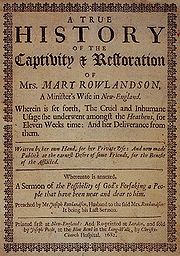
John Hoar
Encyclopedia

King Philip's War
King Philip's War, sometimes called Metacom's War, Metacomet's War, or Metacom's Rebellion, was an armed conflict between Native American inhabitants of present-day southern New England and English colonists and their Native American allies in 1675–76. The war is named after the main leader of the...
. A founding settler of Concord, Massachusetts
Concord, Massachusetts
Concord is a town in Middlesex County, Massachusetts, in the United States. As of the 2010 census, the town population was 17,668. Although a small town, Concord is noted for its leading roles in American history and literature.-History:...
, he is best known for securing the release of Mary Rowlandson
Mary Rowlandson
Mary Rowlandson was a colonial American woman who was captured by Native Americans during King Philip's War and held for 11 weeks before being ransomed. After her release, she wrote a book about her experience, The Sovereignty and Goodness of God: Being a Narrative of the Captivity and...
from Indian captivity at Redemption Rock
Redemption Rock
Redemption Rock is a colonial-era historic site in Princeton, Massachusetts. In 1676, during King Philip's War, the release of Mary Rowlandson from her Native American captors was negotiated atop a granite ledge...
.
Ransom of Mary Rowlandson
On Feb. 10, 1676, during an Indian attack on her hometown of Lancaster, MassachusettsLancaster, Massachusetts
Lancaster is a town in Worcester County, Massachusetts, in the United States. Incorporated in 1653, Lancaster is the oldest town in Worcester County...
Mary Rowlandson
Mary Rowlandson
Mary Rowlandson was a colonial American woman who was captured by Native Americans during King Philip's War and held for 11 weeks before being ransomed. After her release, she wrote a book about her experience, The Sovereignty and Goodness of God: Being a Narrative of the Captivity and...
, wife of the village minister Joseph Rowlandson, was taken prisoner with three of her children by a band of Nipmuc warriors. Hoar, a prominent lawyer and Indian missionary, was requested by the Rev. Rowlandson to act as the colonial representative in the negotiation for her release. Hoar departed Lancaster on April 28, 1676 with two native guides, Nepphonet and Peter Tatatiquinea to meet King Philip's war party at Wachusett Lake, located in what is now Princeton, Massachusetts
Princeton, Massachusetts
Princeton is a town in Worcester County, Massachusetts, United States.It is bordered on the east by Sterling and Leominster, on the north by Westminster, on the northwest by Hubbardston, on the southwest by Rutland, and on the southeast by Holden....
. On May 2, after eleven weeks in captivity, Rowlandson was released to Hoar for a £20 ransom at the glacial stone outcropping known today as Redemption Rock
Redemption Rock
Redemption Rock is a colonial-era historic site in Princeton, Massachusetts. In 1676, during King Philip's War, the release of Mary Rowlandson from her Native American captors was negotiated atop a granite ledge...
. Rowlandson would go on to write a famous narrative of her experience as a captive, The Sovereignty and Goodness of God: Being a Narrative of the Captivity and Restoration of Mrs. Mary Rowlandson which became a bestseller throughout the English speaking world. It is considered to be a seminal work in the American literary genre of captivity narratives and also ranks as the first published book written by a colonial American woman.
Life and Family
John Hoar was born in 1622 in Gloucester, Gloucestershire, England. He died on 2 Apr 1704 in Concord, Middlesex Co., Massachusetts. In 1645, he married his wife Alice, who is believed to have been Alice Lisle, daughter of Sir John LisleJohn Lisle
Sir John Lisle was an English lawyer and politician who sat in the House of Commons at various times between 1640 and 1659. He supported the Parliamentarian cause in the English Civil War and was one of the Regicides of King Charles I of England...
and Lady Alice Beconshaw
Alice Lisle
Lady Alice Lisle , commonly known as Dame Alicia Lisle or Dame Alice Lyle, was a landed lady of the English county of Hampshire, who was executed for harbouring fugitives after the defeat of the Monmouth Rebellion at the Battle of Sedgemoor.-Family:Dame Alice was a daughter of Sir White Beconshaw...
, however only one historical reference to this exists, which only states her Lisle connection as a mere possibilty. Other historians believe that his wife was Alice Sidney, daughter of Philip Sidney and Lady Alicia Sidney, and granddaughter of Barbara Gamage
Barbara Gamage
Barbara Sidney, Countess of Leicester was a Welsh heiress, and the first wife of Robert Sidney, 1st Earl of Leicester.Barbara Gamage inherited Coity Castle, Glamorgan, on the death of her father, John Gamage, in 1584, and became the ward of Sir Edward Stradling of St Donat's Castle, Glamorgan,...
and Robert Sidney, 1st Earl of Leicester
Robert Sidney, 1st Earl of Leicester
Robert Sidney, 1st Earl of Leicester , second son of Sir Henry Sidney, was a statesman of Elizabethan and Jacobean England. He was also a patron of the arts and an interesting poet...
. Robert Sidney was coincidentally granted the title of Viscount Lisle
Viscount Lisle
The title of Viscount Lisle has been created six times in the Peerage of England. The first creation, on 30 October 1451, was for John Talbot, 1st Baron Lisle. Upon the death of his son Thomas at the Battle of Nibley Green in 1470, the viscountcy became extinct and the barony abeyant.In 1475, the...
on 4 May 1605, allowing the "Lisle" title to be passed on through to his descendants, adding further confusion for researchers in search of the identity of Hoar's wife. Currently, no physical or reliable evidence exists providing John Hoar's wife's maiden name, as many early records from the Concord colony have been lost. Their children were Mary, Elizabeth, Joanna, and Daniel.

